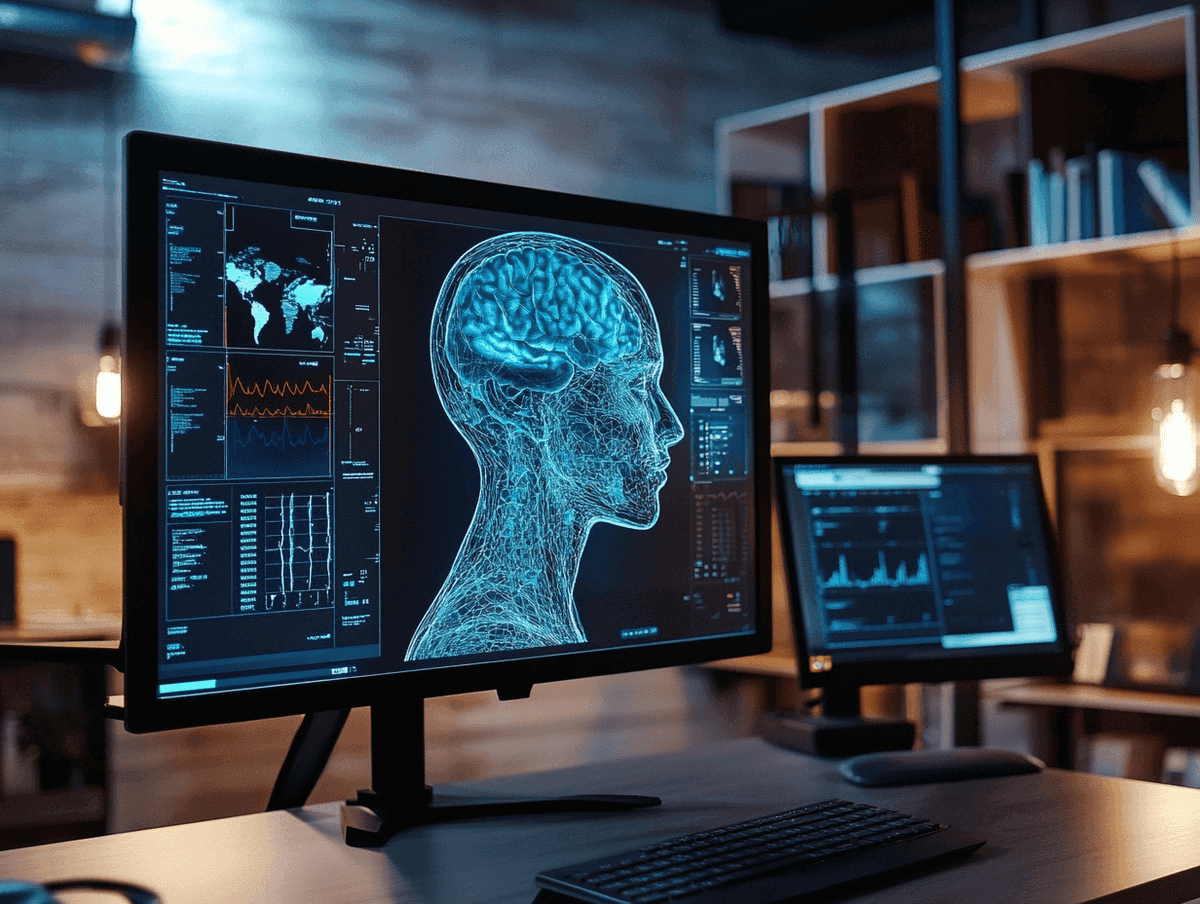EHR software development is about building systems that help healthcare providers manage patient records efficiently. In this article, we’ll walk you through the development steps, key features, and benefits to ensure you create a robust EHR system that enhances patient care and operational efficiency.
Key Takeaways
– comprehensive patient data sharing across healthcare providers, significantly enhancing care coordination and patient outcomes.
– Customizable EHR software development is essential to meet diverse healthcare needs, with key features including patient portals, clinical decision support, and seamless data exchange.
– Future trends in EHR development focus on integrating AI, mobile access, and blockchain technology, promising improved interoperability, patient engagement, and data security.
Understanding EHR Software Development

EHR systems are the backbone of modern healthcare, providing digital solutions for managing and sharing patient health information. Unlike Electronic Medical Records (EMRs), which are confined to a single facility, EHRs facilitate data exchange across multiple providers, thereby enhancing the quality of care. This distinction is crucial as it underscores the expansive capabilities of electronic health record systems and the importance of an EMR system, making them indispensable in today’s electronic health record landscape.
The significance of EHR software development lies in its ability to ensure efficient management of patient records while complying with industry standards. Custom EHR software development, in particular, allows for tailored features that adapt to the specific workflow requirements of healthcare providers. This customization is not just a luxury but a necessity, given the diverse needs of healthcare organizations. Additionally, custom emr software development can enhance the overall functionality of these systems. If you want to streamline your operations, consider investing in your own ehr software, emr software, healthcare software, electronic health record development, emr ehr software development, and medical software from a healthcare software development company.
The demand in the EHR market reflects these varied requirements, with healthcare organizations seeking solutions that can integrate seamlessly into their existing systems. From hospital systems to patient-facing applications, the scope of EHR development is vast, catering to a wide array of healthcare needs. This diversity makes custom EHR solutions particularly valuable as they focus on patient management and user-friendly workflows based on the exact features desired by healthcare providers.
Key Benefits of EHR Systems for Healthcare Providers
One of the most compelling benefits of EHR systems is their ability to enhance patient care by facilitating data sharing across multiple healthcare settings. Imagine a scenario where a patient’s medical history, prescriptions, and test results are instantly accessible to any healthcare provider involved in their care. This level of accessibility not only improves care coordination but also leads to better patient outcomes.
EHR systems play a crucial role in supporting quality improvement programs and value-based care by:
– Tracking patient metrics.
– Providing immediate access to critical patient information, aiding healthcare providers in making informed decisions and enhancing patient care.
– Significantly reducing medication errors by providing alerts and reminders about potential drug interactions or allergies.
This functionality is vital for improving treatment accuracy and patient safety.
Reducing administrative tasks with EHR systems enhances usability and efficiency in patient care. Custom EHR systems offer several benefits:
– Streamline workflows
– Eliminate paperwork
– Provide quick access to patient information Enhanced data security through encryption and controlled access ensures that sensitive patient information is well-protected, addressing one of the major concerns in the healthcare industry.
Essential Features of Robust EHR Software
When it comes to EHR systems, several key features stand out as essential for robust functionality. Patient portals, clinical decision support (CDS), and seamless data exchange capabilities are among the most critical elements. These features not only enhance patient engagement and care coordination but also ensure that healthcare providers have the tools they need to deliver high-quality care.
Each of these features plays a unique role in the overall effectiveness of an EHR system. Patient portals provide a self-service access point to medical records, prescriptions, and test results, empowering patients to manage their health and their patient record. Clinical decision support offers real-time, evidence-based recommendations, assisting healthcare providers in making informed decisions.
Seamless data exchange ensures smooth integration and sharing of information among various healthcare providers, which is crucial for comprehensive data migration patient care.
Patient Portals
Patient portals are a game-changer in the realm of EHR systems, significantly enhancing patient engagement. These portals allow individuals to track their health records, view test results, and communicate with healthcare providers, all from the comfort of their homes. This level of accessibility encourages patients to take an active role in their care, leading to better health outcomes.
The integration of mobile solutions into EHR systems further amplifies the benefits of patient portals. Mobile access ensures that patients can manage their health on the go, providing continuity of care and greater patient engagement. This is particularly important in today’s fast-paced world, where convenience is key to maintaining consistent health monitoring and communication with healthcare providers.
Security is another crucial aspect of patient portals. These platforms must offer secure access to health records, protecting sensitive patient data while providing the necessary information for informed decision-making. Ensuring that these portals are user-friendly and intuitive can also help in reducing the learning curve for patients, making it easier for them to navigate their medical histories and engage with their healthcare providers.
Clinical Decision Support (CDS)
Clinical Decision Support (CDS) systems are indispensable features of robust EHR software, providing real-time, evidence-based recommendations that significantly improve treatment outcomes. Alongside CDS and EHR solutions, healthcare CRM software also plays a crucial role in streamlining operations and enhancing patient care. By offering alerts about potential drug interactions, allergies, and diagnosis errors, CDS systems enhance the accuracy of medical decisions and patient safety.
The integration of AI and machine learning into CDS systems is revolutionizing the way healthcare providers approach patient care. These technologies:
– Forecast patient health outcomes
– Identify trends in health data
– Offer personalized treatment plans
– Improve documentation
– Streamline clinical workflows
– Assist in making more informed healthcare decisions.
Incorporating CDS into EHR systems not only supports healthcare providers but also ensures that patients receive the best possible care based on the latest medical evidence. This feature is particularly valuable in complex cases where quick and accurate decision-making is critical. By leveraging the power of technology, CDS systems are helping to transform the healthcare landscape, making it more efficient and effective.
Seamless Data Exchange
Seamless data exchange is a cornerstone of effective EHR systems, ensuring that patient information is accessible to all healthcare providers involved in a patient’s care. Interoperability, or the ability of different systems to communicate and share data, is critical for this functionality. However, achieving true interoperability remains a challenge, often due to the lack of compatibility with legacy systems.
Efforts like the Fast Healthcare Interoperability Resources (FHIR) initiative aim to improve data sharing across different healthcare systems. Using industry-standard protocols and APIs is a recommended solution to enhance interoperability and ensure that data can be seamlessly exchanged. These measures help in providing comprehensive patient information, which is vital for enhancing care coordination and patient outcomes.
EHR systems improve data accessibility, allowing healthcare providers to retrieve patient data from any location with internet access. This capability is particularly important in emergency situations where timely access to patient information can be life-saving. By focusing on seamless data exchange, having an own ehr system ensures that healthcare providers have the information they need to deliver high-quality care. An electronic health record system enhances this process further.
Technology Stack for Building an EHR System
 Choosing the right technology stack is crucial for building a robust EHR system that meets the specific needs of healthcare providers. Frontend development for EHR systems often utilizes frameworks like React, Angular, or Vue.js to create an intuitive and responsive user interface. These frameworks enhance the user experience, making it easier for healthcare providers to navigate the system.
Choosing the right technology stack is crucial for building a robust EHR system that meets the specific needs of healthcare providers. Frontend development for EHR systems often utilizes frameworks like React, Angular, or Vue.js to create an intuitive and responsive user interface. These frameworks enhance the user experience, making it easier for healthcare providers to navigate the system.
On the backend, the following technologies are commonly used:
– Server-side frameworks such as Django and Node.js to manage business logic and database interactions.
– NoSQL databases like MongoDB, which offer flexibility in managing unstructured data, often the case with patient records.
– Cloud platforms such as AWS, Google Cloud, or Microsoft Azure, providing the necessary scalability and security for hosting EHR applications.
Security is a paramount concern in EHR development, and implementing measures like OAuth2 for authentication is crucial to protect sensitive health data. A well-chosen technology stack ensures that the EHR system is efficient, secure, and capable of meeting the diverse needs of healthcare organizations. Leveraging the right technologies enables developers to build an EHR system that enhances patient care and meets regulatory compliance.
The Development Team Required for Custom EHR Software
Creating a custom EHR software solution requires a diverse team of specialists who can cover all aspects of the development process. Key roles include:
– Project lead
– Project manager
– Application analyst
– Developer Each of these roles plays a crucial part in ensuring that the EHR system is tailored to meet the specific needs of healthcare professionals and healthcare providers.
The application analyst acts as a bridge between clinical requirements and technical specifications, ensuring that the EHR system aligns with the practical needs of healthcare providers. Quality Assurance (QA) roles are equally important, as they identify and address issues in the EHR system prior to its launch, ensuring that it functions smoothly and meets all regulatory requirements.
The IT lead is responsible for managing all technical aspects of the EHR deployment, including support and training for end users. A well-coordinated development team ensures that the EHR system is not only functional but also user-friendly and compliant with industry standards. By bringing together the right mix of skills and expertise, healthcare organizations can develop a robust EHR system that enhances patient care and operational efficiency.
Steps to Create an EHR Software Solution
Creating an EHR software solution involves several critical steps to create ehr software:
– Product Discovery: identifying the required features and developing a flowchart of processes.
– Understanding client requirements, which can be highly specialized for EHR systems.
– Evaluation.
– Prototyping.
– Development.
– Testing.
The EHR software development process involves multiple stages to ensure both functionality and regulatory compliance. For the MVP version of an EHR system, patient portal functionality must be included. By following a structured approach, developers can create an EHR solution that meets the needs of healthcare providers and complies with industry standards.
Idea Validation

Idea validation is a crucial step in the EHR software development process, as it assesses the feasibility and market fit of the proposed solution. This involves analyzing factors such as potential, probability, and market fit to ensure that the idea can be successfully implemented. Software agencies evaluate the vision, requirements, and competitors while assessing an EHR software idea.
Establishing a minimum viable product (MVP) allows developers to collect feedback and refine the app development EHR concept. This iterative process helps in identifying any potential issues early on and making necessary adjustments to meet customer expectations. By validating the idea thoroughly, developers can ensure that the final product is both practical and market-ready.
Prototype Creation
Developing a prototype is an essential step in understanding how the EHR software works and identifying areas for improvement. Wireframes and user journey maps are created during the final design process. These tools help to define the look and feel of the system. This helps in visualizing the user experience and making necessary adjustments to enhance usability.
UX/UI design is emphasized during the prototype phase to ensure ease of navigation for users. Refining the design and functionality based on feedback is crucial to meet customer expectations and create a user-friendly EHR system. By focusing on prototype creation, developers can address potential issues early and ensure a smooth development process.
Development and Testing
After the prototype phase, the development of the EHR software and ehr system development begins in earnest. This stage follows a comprehensive business analysis and estimation process. Once the vision for the system is clear, the architecture design is the next step, laying the foundation for the entire development process.
Rigorous testing is conducted across multiple platforms and networks to ensure that the EHR software systems functions correctly and complies with healthcare regulations. The goal of this testing phase is to provide a smooth user experience and to identify and fix any bugs or issues before the software is launched. This thorough approach helps in delivering a reliable and robust EHR system that meets the high standards of the healthcare industry.
The final step in the development process is the launch of the custom EMR/EHR software. This stage involves deploying the software, training the end-users, and providing ongoing support to ensure that the system operates smoothly. Following these steps allows developers to create an effective and compliant EHR solution that enhances patient care and operational efficiency through custom emr development.
Ensuring Regulatory Compliance in EHR Software Development
Ensuring regulatory compliance is a critical aspect of EHR software development. EHR systems must adhere to regulations such as:
– HIPAA
– GDPR
– HL7 These regulations ensure that patient data is handled securely and ethically. Compliance with these regulations is not just a legal requirement but also a vital component of building trust with healthcare providers and patients.
EHR developers must ensure that their systems comply with both administrative and technical safeguards specified by relevant regulations. This includes implementing adequate security measures to protect electronic health information, as mandated by the Security Rule of HIPAA. Compliance must be validated during the testing phase of the EHR software to ensure that all regulatory requirements are met.
Ongoing risk assessments are essential to identify and manage vulnerabilities in handling electronic protected health information. Regular audits and documentation updates are also necessary to maintain compliance with evolving regulations. By prioritizing regulatory compliance, EHR developers can create systems that are secure, reliable, and trusted by healthcare providers.
Asking clients about their specific HIPAA compliance requirements before starting EHR software development is crucial. Understanding these requirements helps in designing a system that meets the unique needs of each healthcare organization. By ensuring regulatory compliance, developers can build robust EHR systems that protect patient data and enhance healthcare quality.
Overcoming Common Challenges in EHR Implementation

Implementing an EHR system comes with its own set of challenges. One major issue multiple healthcare providers face is dealing with multiple systems that don’t communicate with each other. This lack of interoperability can hinder the seamless exchange of patient data, making it difficult to achieve comprehensive care coordination.
Resistance to new EHR systems is another common challenge. Factors contributing to this resistance include:
– Complex interfaces
– Workflow interruptions
– Time-intensive documentation Poor usability can further hinder efficiency and lead to frustration among healthcare providers. Addressing these issues requires a focus on user-friendly design and thorough training for end users.
The timeline for implementing an EHR system can vary based on factors such as the size of the healthcare facility, system complexity, and customization needs. An effective EHR implementation team must include a diverse set of specialists to cover planning, development, testing, and deployment. Involving clinical staff such as physician champions and nurse leads ensures that the EHR system meets the practical needs of healthcare providers.
Super users play an essential role during EHR implementation by helping train other staff members and resolving user issues. EHR integration services aim to ensure that software systems can communicate smoothly, addressing one of the major challenges in EHR implementation. By overcoming these challenges, healthcare providers can successfully adopt EHR systems that enhance patient care and
Cost Considerations for EHR Software Development
The cost of developing an EHR software solution is influenced by several factors, including:
– The feature set
– Development team and resources
– Geographical location
– The number of platforms
Custom EHR software development is often considered cost-efficient because the long-term benefits generally outweigh the initial costs, and it helps avoid hidden fees associated with off-the-shelf custom ehr system.
The cost range for building an EHR system can be between $40,000 to $100,000, depending on the complexity and specific requirements. EHR development and implementation can be very expensive, contributing to significant short-term costs that need consideration. For example, implementation expenses for a multi-physician practice can reach approximately $162,000.
Practices typically invest around $1,200 annually per user on EHR systems. Maintenance costs can average around $1,500 per physician monthly. The total cost of ownership (TCO) for cloud EHR systems over five years can be around $58,000, while on-premise systems can have a lower TCO, estimated at $48,000. Considering both direct costs like software licensing and indirect costs such as lost productivity is essential for accurate budgeting.
Solo practices face higher costs per user compared to larger practices, averaging $8,400 yearly for system expenses. Pricing for popular EHR systems varies widely based on the deployment method and included features. By understanding these cost considerations, healthcare providers can make informed decisions about investing in EHR software solutions.
Future Trends in EHR Software Development
As we look to the future, several trends are set to transform the landscape of EHR software development. AI and machine learning technologies are being integrated into EHR systems to analyze patient data, predict health outcomes, and identify patterns. By 2025 and beyond, AI is expected to enhance the functionality and usability of EHR systems, making them more efficient and effective.
Mobile access to EHR systems is another significant trend, allowing patients to schedule appointments, view test results, and receive health notifications in real-time. This access not only improves patient engagement but also provides healthcare providers with real-time data, enhancing the quality of care.
Blockchain technology is being explored to enhance data security and patient privacy in health records. By providing a decentralized and immutable ledger, blockchain can address many of the security concerns associated with EHR systems. This technology has the potential to revolutionize how patient data is stored and accessed, ensuring greater trust and transparency. Other cutting-edge technologies, such as virtual reality in healthcare, are also transforming patient care and the overall healthcare experience.
The expected transformations in EHR systems by 2025 and beyond include improved interoperability, more personalized patient care, and enhanced data analytics. These trends will not only improve the efficiency of healthcare providers but also enhance patient outcomes. By staying ahead of these trends, healthcare organizations can leverage the latest technologies to provide better care and achieve greater operational efficiency.
Summary

In summary, EHR software development is a complex but essential aspect of modern healthcare. From understanding the nuances between EHR and EMR to exploring the benefits, essential features, and technology stack for EHR systems, this guide has provided a comprehensive overview of what it takes to build a robust EHR solution. Key benefits include enhanced patient care, improved care coordination, and reduced medication errors.
The development process involves several critical steps, including idea validation, prototype creation, and rigorous testing to ensure functionality and compliance. Overcoming common challenges in EHR implementation, such as interoperability issues and resistance to new systems, requires a well-coordinated team and user-friendly design. Cost considerations are also crucial, with custom EHR software offering long-term benefits that often outweigh initial expenses.
Looking ahead, future trends such as AI integration, mobile access, and blockchain technology are set to revolutionize EHR systems. By embracing these trends, healthcare providers can enhance patient outcomes and achieve greater efficiency. As we move forward, the importance of EHR systems in improving healthcare quality and operational efficiency cannot be overstated. Stay ahead of the curve and invest in the future of healthcare with robust and compliant EHR solutions.






















 Choosing the right technology stack is crucial for building a robust EHR system that meets the specific needs of healthcare providers. Frontend development for EHR systems often utilizes frameworks like React, Angular, or Vue.js to create an intuitive and responsive user interface. These frameworks enhance the user experience, making it easier for healthcare providers to navigate the system.
Choosing the right technology stack is crucial for building a robust EHR system that meets the specific needs of healthcare providers. Frontend development for EHR systems often utilizes frameworks like React, Angular, or Vue.js to create an intuitive and responsive user interface. These frameworks enhance the user experience, making it easier for healthcare providers to navigate the system.






